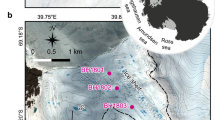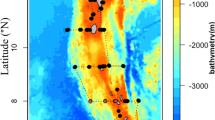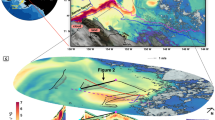Abstract
Aleutian eddies are mesoscale anticyclonic eddies formed within the Alaskan Stream region between 180° meridian and 170° E south of the Aleutian Islands. They propagate southwestward after the isolation from the Alaskan Stream and pass through the Western Subarctic Gyre. We compared hydrographic structures of three Aleutian eddies observed during summer, west of 170° E (Eddy A) and east of 170° E (Eddies B and C). In each eddy, a subsurface dichothermal water (3.0–4.0 °C) was observed above a subsurface mesothermal water (4.0–4.5 °C). The minimum temperature in the dichothermal water at around a depth of 100 m was colder in Eddy A (2.8 °C) than in Eddies B and C (3.0–3.2 °C). This difference could be ascribed to wintertime cooling and influence of surrounding waters during spring warming period. The wintertime cooling makes the dichothermal water colder for eddies isolated from the Alaskan Stream region for a longer time. Particle-tracking experiments using re-analysis products from a data-assimilative eddy resolving ocean model suggested that the dichothermal water within Eddy A was cooled by the entrainment of surrounding colder water even during the spring warming period. The mesothermal waters at depth around 250 m demonstrated similarity among the observed eddies, and the maximum temperature in the mesothermal water within Eddy A (4.3 °C) was close to that of Eddies B and C (4.2 °C) in the in situ observations. These results indicated that the dichothermal water of Aleutian eddies modifies over time, whereas the mesothermal water maintains the original feature as they propagate southwestward from the Alaskan Stream region to the Western Subarctic Gyre.











Similar content being viewed by others
References
Brown MT, Lippiatt SM, Lohan MC, Bruland KW (2012) Trace metal distributions within a Sitka eddy in the northern Gulf of Alaska. Limnol Oceanogr 57(2):503–518. doi:10.4319/lo.2012.57.2.0503
Chelton DB, Schlax MG, Samelson RM, de Szoeke RA (2007) Global observations of large oceanic eddies. Geophys Res Lett 34, L15606. doi:10.1029/2007GL030812
Collecte Localisation Satellites (2014) SSALTO/DUACS user handbook: (M) SLA and (M) ADT near real time and delayed time products, version 4 rev. 1, rep. SALP-MU-P-EA-21065-CLS. CLS, Ramonville-St-Agne, France, p 72
Crawford WR (2005) Heat and fresh water transport by eddies into the Gulf of Alaska. Deep-Sea Res II 52:893–908. doi:10.1016/j.dsr2.2005.02.003
Crawford WR, Brickley PJ, Thomas AC (2007) Mesoscale eddies dominate surface phytoplankton in northern Gulf of Alaska. Prog Oceanogr 75:287–303. doi:10.1016/j.pocean.2007.08.016
Favorite F (1967) The Alaskan Stream. In N Pac Fish Comm Bull 21:1–20, http://www.npafc.org/new/inpfc/INPFC%20Bulletin/Bull%20No.21/Bull21%20p1-20%20%28Favorite%29.pdf
Fujii Y, Kamachi M (2003) A reconstruction of observed profiles in the sea east of Japan using vertical coupled temperature-salinity EOF modes. J Oceanogr 59(2):173–186. doi:10.1023/A:1025539104750
GHRSST Science Team (2011) The recommended GHRSST data specification (GDS) 2.0, document revision 4. The GHRSST International Project Office, Physical Oceanography Distributed Active Archive Center, NASA Jet Propulsion Laboratory, DAAC, Pasadena, p 123
Grist JP, Josey SA (2003) Inverse analysis adjustment of the SOC air-sea flux climatology using ocean heat transport constraints. J Clim 16(20):3274–3294. doi:10.1175/1520-0442(2003)016<3274:IAAOTS>2.0.CO;2
Henson SA, Thomas AC (2008) A census of oceanic anticyclonic eddies in the Gulf of Alaska. Deep-Sea Res I 55:163–176. doi:10.1016/j.dsr.2007.11.005
Hokkaido University (2011) Data record of oceanographic observation and exploratory fishing no. 54. In: Saitoh, SI (ed) Faculty of Fisheries Sciences, Hokkaido University, Hakodate, Japan, p 192
Ikenoue T, Ueno H, Takahashi K (2012) Rhizoplegma boreale (Radiolaria): a tracer for mesoscale eddies from coastal areas. J Geophys Res 117, C04001. doi:10.1029/2011JC007728
Inatsu M (2009) The neighbor enclosed area tracking algorithm for extra-tropical wintertime cyclones. Atmos Sci Lett 10:267–272. doi:10.1002/asl.238
Ladd C, Kachel NB, Mordy CW, Stabeno PJ (2005) Observations from a Yakutat eddy in the northern Gulf of Alaska. J Geophys Res 110, C03003. doi:10.1029/2004JC002710
Ladd C, Mordy CW, Kachel NB, Stabeno PJ (2007) Northern Gulf of Alaska eddies and associated anomalies. Deep-Sea Res I 54:487–509. doi:10.1016/j.dsr.2007.01.006
Ohtani K (1973) Oceanographic structures in the Bering Sea. Fac Fish Hokkaido Univ 21(1):65–106, http://hdl.handle.net/2115/21855
Ohtani K, Onishi H, Kobayashi N, Anma G (1997) Baroclinic flow referred to the 3000 m reference level across the 180° transect in the subarctic North Pacific. Bull Fac Fish Hokkaido Univ 48(3):53–64, http://hdl.handle.net/2115/24162
Okubo A (1970) Horizontal dispersion of floatable particles in the vicinity of velocity singularity such as convergences. Deep-Sea Res 17(3):445–454. doi:10.1016/0011-7471(70)90059-8
Onishi H (2001) Spatial and temporal variability in a vertical section across the Alaskan Stream and Subarctic Current. J Oceanogr 57(1):79–91. doi:10.1023/A:1011178821299
Onishi H, Ohtani K (1999) On seasonal and year-to-year variation in flow of the Alaskan Stream in the central North Pacific. J Oceanogr 55(5):597–608. doi:10.1023/A:1007840802296
Prants SV, Andreev AG, Budyansky MV, Uleysky MY (2013) Impact of mesoscale eddies on surface flow between the Pacific Ocean and the Bering Sea across the Near Strait. Ocean Model 72:143–152. doi:10.1016/j.ocemod.2013.09.003
Reed RK, Stabeno PJ (1993) The recent return of the Alaskan Stream to Near Strait. J Mar Res 51(3):515–527. doi:10.1357/0022240933224025
Reed RK, Stabeno PJ (1999) Recent full-depth survey of the Alaskan Stream. J Oceanogr 55(1):79–85. doi:10.1023/A:1007813206897
Rogachev KA, Shlyk NV (2009) The increased radius of the Aleutian eddies and their long-term evolution. Russ Meteorol Hydrol 35(3):206–210. doi:10.3103/S1068373910030076
Rogachev K, Shlyk N, Carmack E (2007) The shedding of mesoscale eddies from the Alaskan Stream and westward transport of warm water. Deep-Sea Res II 54:2643–2656. doi:10.1016/j.dsr2.2007.08.017
Saito R, Yamaguchi A, Yasuda I, Ueno H, Ishiyama H, Onishi H, Imai I (2014) Influences of mesoscale anticyclonic eddies on zooplankton community south of the western Aleutian Islands during the summer of 2010. J Plankton Res 36(1):117–128. doi:10.1093/plankt/fbt087
Stabeno PJ, Hristova HS (2014) Observations of the Alaskan Stream near the Samalga Pass and its connection to the Bering Sea: 2001–2004. Deep-Sea Res I 88:30–46. doi:10.1016/j.dsr.2014.03.002
Ueno H, Yasuda I (2000) Distribution and formation of the mesothermal structure (temperature inversions) in the North Pacific subarctic region. J Geophys Res 105(C7):16885–16897. doi:10.1029/200JC900020
Ueno H, Yasuda I (2005) Temperature inversions in the subarctic Pacific. J Phys Oceanogr 35:2444–2456. doi:10.1175/JPO2829.1
Ueno H, Oka E, Suga T, Onishi H (2005) Seasonal and interannual variability of temperature inversions in the subarctic North Pacific. Geophys Res Lett 32, L20603. doi:10.1029/2005GL023948
Ueno H, Oka E, Suga T, Onishi H, Roemmich D (2007) Formation and variation of temperature inversions in the eastern subarctic North Pacific. Geophys Res Lett 34, L05603. doi:10.1029/2006GL028715
Ueno H, Freeland H, Crawford WR, Onishi H, Oka E, Sato K, Suga T (2009) Anticyclonic eddies in the Alaskan Stream. J Phys Oceanogr 39:934–951. doi:10.1175/2008JPO3948.1
Ueno H, Crawford WR, Onishi H (2010) Impact of Alaskan Stream eddies on chlorophyll distribution in the North Pacific. J Oceanogr 66(3):319–328. doi:10.1007/s10872-010-0028-6
Ueno H, Yasuda I, Itoh S, Onishi H, Hiroe Y, Suga T, Oka E (2012) Modification of a Kenai eddy along the Alaskan stream. J Geophys Res 117, C08032. doi:10.1029/2011JC007506
Weiss J (1991) The dynamics of enstrophy transfer in two dimensional hydrodynamics. Phys D 48(2–3):273–294. doi:10.1016/0167-2789(91)90088-Q
Acknowledgments
We express our thanks to the captain, officers, and crew members of T/S Oshoro-maru, School of Fisheries Sciences, Hokkaido University and the members of Physical Oceanography Laboratory, Graduate School of Fisheries Sciences, Hokkaido University for their help in data collection at sea. The altimeter products were produced by SSALTO/DUCSCS and distributed by AVISO with support from Collecte Localisation Satellites. The FRA-ROMS re-analysis dataset were generated and provided by National Research Institute of Fisheries Science, Fisheries Research Agency of Japan. The sea surface temperature (GHRSST) was provided by Physical Oceanography Distributed Active Archive Center, NASA Jet Propulsion Laboratory. The climatological net surface heat flux was produced and provided by National Oceanography Centre, Natural Environment Research Council. The present study was partially supported by Grant-in-Aid for JSPS Fellows 25–271, KAKENHI Grant 25257206/15H05818 of the Japan Society for the Promotion of Science (JSPS). We also thank Professor Joerg-Olaf Wolff, Chief Editor; Dr. Pierre De Mey, Associate Editor of Ocean Dynamics; and two anonymous reviewers. Their valuable comments were helpful and greatly improved the present manuscript.
Author information
Authors and Affiliations
Corresponding author
Additional information
Responsible Editor: Pierre De Mey
Electronic supplementary material
Below is the link to the electronic supplementary material.
Fig. S1
Isolation of Eddy A from the Alaskan Stream region from the late March to the mid-April 2010. Contour shows absolute dynamic height (cm) from AVISO. Bold contours (10 and 12 cm in the absolute dynamic height) correspond to the outer edge of Alaskan Stream (PPTX 208 kb)
Rights and permissions
About this article
Cite this article
Saito, R., Yasuda, I., Komatsu, K. et al. Subsurface hydrographic structures and the temporal variations of Aleutian eddies. Ocean Dynamics 66, 605–621 (2016). https://doi.org/10.1007/s10236-016-0936-0
Received:
Accepted:
Published:
Issue Date:
DOI: https://doi.org/10.1007/s10236-016-0936-0




